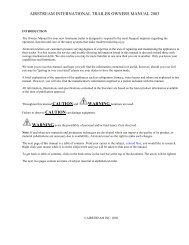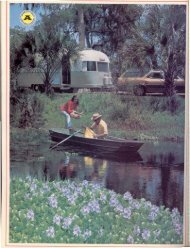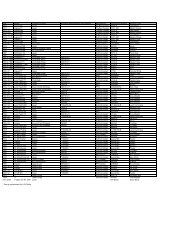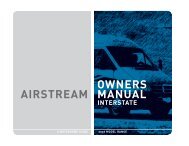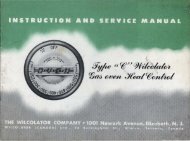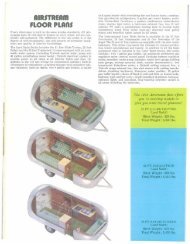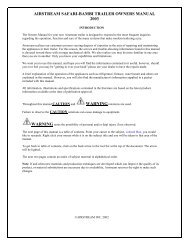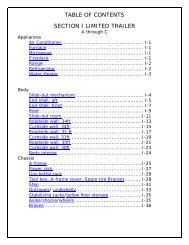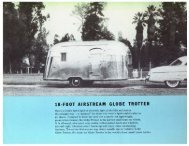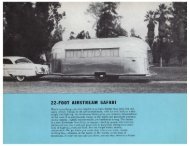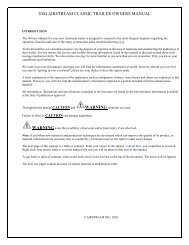Classic - Airstream
Classic - Airstream
Classic - Airstream
You also want an ePaper? Increase the reach of your titles
YUMPU automatically turns print PDFs into web optimized ePapers that Google loves.
Neglect is expensive. Care costs little. Check your batteries regularly. Follow<br />
these guidelines to extend the life of your low-maintenance battery:<br />
1. Maintain Water Level. ADD DISTILLED WATER TO CELLS AS NECESSARY.<br />
Check the electrolyte level at least once a month. When you are traveling steadily<br />
and for an extended period of time, or if you are in climates above 90 degrees F,<br />
check the electrolyte level about every two weeks. Your battery has removable<br />
vent caps, you should regularly check the water level and add distilled water<br />
when it is low. Do not add water to a battery in freezing temperatures unless<br />
the vehicle will be put to use at once, otherwise the added water may freeze.<br />
Do not fill battery above the split ring in filler opening. DO NOT MEASURE<br />
SPECIFIC GRAVITY IMMEDIATELY after adding water. The water must mix with<br />
the electrolyte by charging or by driving a few miles.<br />
2. Keep Terminals Clean. Visually inspect the terminals and cables at least<br />
once a year, especially in hot temperatures, for signs of corrosion. If dirty or<br />
corroded, the battery terminals and the inside portion of the cable connector<br />
should be scraped or brushed until both of these surfaces are shiny bright. The<br />
cable connectors should then be reconnected to the battery and tightened.<br />
This will ensure a good connection and proper starting. RECONNECT THE<br />
BATTERY CABLES TO THE CORRECT BATTERY POSTS. The black cable<br />
should be connected to the negative (-) post and the red cable to the (+) post.<br />
The polarity of your tow vehicle must also be negative (-) ground since it must<br />
Electrical<br />
always match the trailer. Most tow vehicles are negative grounded, but always<br />
check your vehicle owner’s manual to be sure. The complete assembly, battery<br />
post and cable connector should be coated with heavy body mineral grease,<br />
petroleum grease or petroleum jell.<br />
3) Keep Case Clean. Keep the top of the battery clean of heavy dirt and oil with<br />
a cloth dampened by ammonia or a 50/50 solution of baking soda and water.<br />
Then rinse with clear water and allow to thoroughly dry. Care must be used to<br />
make sure soda is not allowed to enter battery cells.<br />
4) Keep Battery Charged. If your vehicle is not used regularly, it may be necessary<br />
to charge your battery before use. Lack of use is hard on a battery. Any unused<br />
battery, regardless of its chemistry, will self-discharge over time and, if allowed<br />
to remain discharged, will undergo severe positive grid corrosion and battery<br />
failure. The rate of discharge depends on the type of battery and the storage<br />
temperature. So, it’s important to keep your battery charged by connecting you<br />
shoreline monthly. If you prefer that your mechanic take care of your battery, be<br />
sure to ask him (1) to maintain the water level and (2) to keep the connections<br />
and case clean of corrosion and dirt.<br />
As batteries age, do their maintenance requirements change? Yes. Typically<br />
the specific gravity gets higher and gassing increases due to some battery<br />
deterioration and/or loss of reserve capacity. An older battery normally requires<br />
G<br />
G - 3



